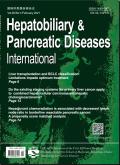Fibrotic liver extracellular matrix induces cancerous phenotype in biomimetic micro-tissues of hepatocellular carcinoma model
IF 4.4
3区 医学
Q2 GASTROENTEROLOGY & HEPATOLOGY
Hepatobiliary & Pancreatic Diseases International
Pub Date : 2025-02-01
DOI:10.1016/j.hbpd.2024.09.003
引用次数: 0
Abstract
Background
Despite considerable advancements in identifying factors contributing to the development of hepatocellular carcinoma (HCC), the pathogenesis of HCC remains unclear. In many cases, HCC is a consequence of prolonged liver fibrosis, resulting in the formation of an intricate premalignant microenvironment. The accumulation of extracellular matrix (ECM) is a hallmark of premalignant microenvironment. Given the critical role of different matrix components in regulating cell phenotype and function, this study aimed to elucidate the interplay between the fibrotic matrix and malignant features in HCC.
Methods
Liver tissues from both control (normal) and carbon tetrachloride (CCl4)-induced fibrotic rats were decellularized using sodium dodecyl sulfate (SDS) and Triton X-100. The resulting hydrogel from decellularized ECM was processed into micro-particles via the water-in-oil emulsion method. Micro-particles were subsequently incorporated into three-dimensional liver biomimetic micro-tissues (MTs) comprising Huh-7 cells, human umbilical vein endothelial cells (HUVECs), and LX-2 cells. The MTs were evaluated using the 3-(4,5-dimethylthiazol-2-yl)-5-(3-carboxymethoxyphenyl)-2-(4-sulfophenyl)-2H-tetrazolium (MTS) assay at day 11, immunofluorescence staining, immunoblotting, and spheroid migration assay at day 14 after co-culture.
Results
Fibrotic matrix from CCl4-treated rat livers significantly enhanced the growth rate of the MTs and their expression of CCND1 as compared to the normal one. Fibrotic matrix, also induced the expression of epithelial-to-mesenchymal transition (EMT)-associated genes such as TWIST1, ACTA2, MMP9, CDH2, and VIMENTIN in the MTs as compared to the normal matrix. Conversely, the expression of CDH1 and hepatic maturation genes HNF4A, ALB, CYP3A4 was decreased in the MTs when the fibrotic matrix was used. Furthermore, the fibrotic matrix increased the migration of the MTs and their secretion of alpha-fetoprotein.
Conclusions
Our findings suggest a regulatory role for the fibrotic matrix in promoting cancerous phenotype, which could potentially accelerate the progression of malignancy in the liver.
肝纤维化细胞外基质诱导肝细胞癌模型生物仿真微组织中的癌表型
尽管在确定导致肝细胞癌(HCC)发生的因素方面取得了很大进展,但 HCC 的发病机制仍不清楚。在许多情况下,HCC 是长期肝纤维化的结果,导致形成错综复杂的恶性前微环境。细胞外基质(ECM)的积累是恶性前微环境的标志。鉴于不同基质成分在调节细胞表型和功能方面的关键作用,本研究旨在阐明纤维化基质与 HCC 恶性特征之间的相互作用。
本文章由计算机程序翻译,如有差异,请以英文原文为准。
求助全文
约1分钟内获得全文
求助全文
来源期刊
CiteScore
5.40
自引率
6.10%
发文量
152
审稿时长
3.0 months
期刊介绍:
Hepatobiliary & Pancreatic Diseases International (HBPD INT) (ISSN 1499-3872 / CN 33-1391/R) a bimonthly journal published by First Affiliated Hospital, Zhejiang University School of Medicine, China. It publishes peer-reviewed original papers, reviews and editorials concerned with clinical practice and research in the fields of hepatobiliary and pancreatic diseases. Papers cover the medical, surgical, radiological, pathological, biochemical, physiological and historical aspects of the subject areas under the headings Liver, Biliary, Pancreas, Transplantation, Research, Special Reports, Editorials, Review Articles, Brief Communications, Clinical Summary, Clinical Images and Case Reports. It also deals with the basic sciences and experimental work. The journal is abstracted and indexed in SCI-E, IM/MEDLINE, EMBASE/EM, CA, Scopus, ScienceDirect, etc.

 求助内容:
求助内容: 应助结果提醒方式:
应助结果提醒方式:


